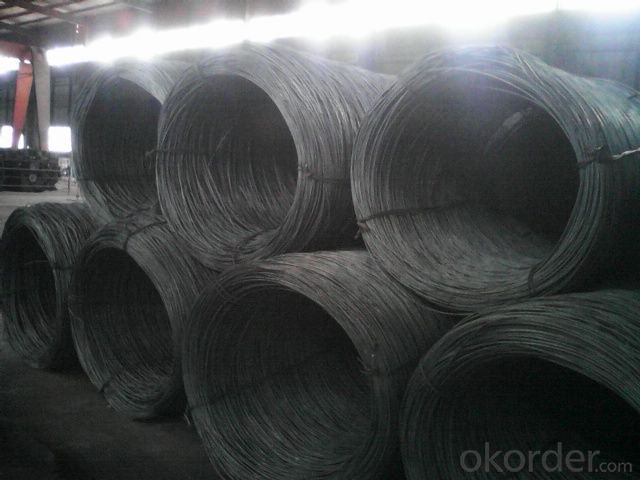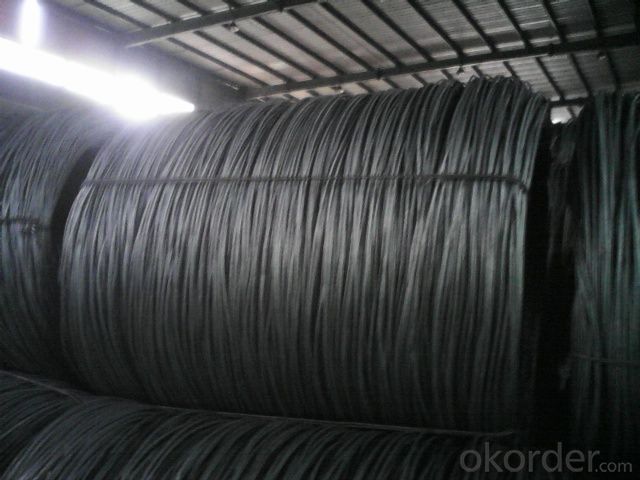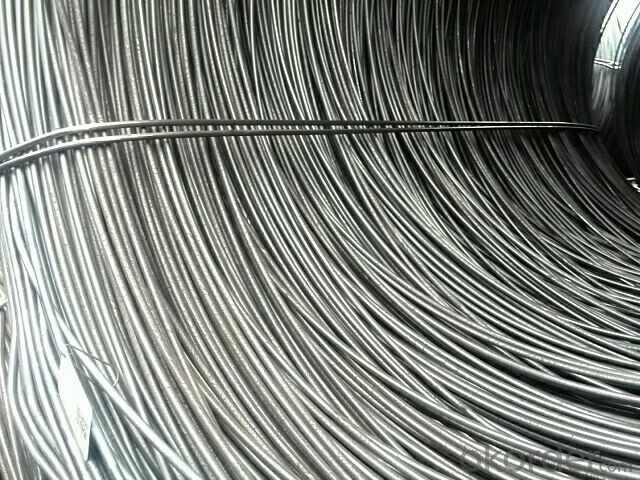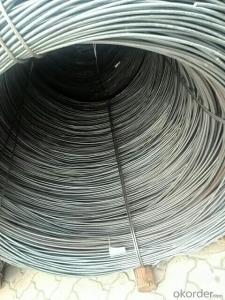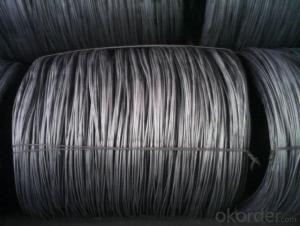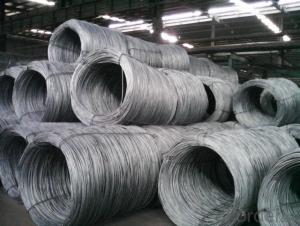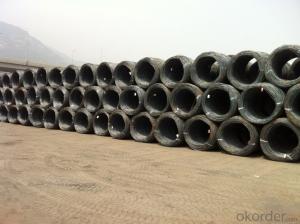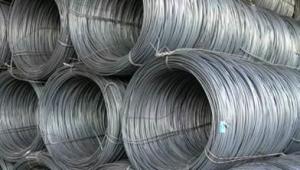Wire Rod Sae1006B and Q235 with High quality
- Loading Port:
- Tianjin
- Payment Terms:
- TT or LC
- Min Order Qty:
- 25 m.t
- Supply Capability:
- 20000 m.t/month
OKorder Service Pledge
OKorder Financial Service
You Might Also Like
Product Description:
OKorder is offering Wire Rod Sae1006B and Q235 with High quality at great prices with worldwide shipping. Our supplier is a world-class manufacturer of steel, with our products utilized the world over. OKorder annually supplies products to European, North American and Asian markets. We provide quotations within 24 hours of receiving an inquiry and guarantee competitive prices.
Product Applications:
Wire Rod Sae1006B and Q235 with High quality ideal for structural applications and are widely used in the construction of buildings and bridges, and the manufacturing, petrochemical, and transportation industries.
Product Advantages:
Wire Rod Sae1006B and Q235 with High quality are durable, strong, and resist corrosion.
Main Product Features:
· Premium quality
· Prompt delivery & seaworthy packing (30 days after receiving deposit)
· Corrosion resistance
· Can be recycled and reused
· Mill test certification
· Professional Service
· Competitive pricing
Product Description:
Specifications of Wire Rod Sae1006B and Q235 with High quality :
Steel Grade: sae1006+sae1008B , Standard: GB Diameter: 5.5mm, 6.5mm, 7mm,8mm,9mm,10mm,12mm,14mm
Diameter Tolerance:±0.3mm 6.5mm can be drawing into 2mm/8.0mm can be drawing into 3mm
Brand Name: N-RIVER Place of Origin: Hebei, China Mainland Application: construction, building etc
Chemical Composition:
Please kindly find our chemistry of our material based on Q235 as below for your information
Trademark | Rank | Chemical composition (quality score) % | ||||||
C | Si | Mn | S | P | ||||
| ≤ |
| ≤ | ≤ | ||||
Q235 | A | 0.14-0.22 | 0.30 | 0.30-0.65 | 0.050 | 0.045 | ||
Q235 | B | 0.12-0.20 | 0.30 | 0.30-0.70 | 0.045 | 0.045 | ||
Trademark | Rank | Pulling Test | ||||||
Bend PointΔs/Mpa | Tensile Strength | Elongation Ratioδ5% | ||||||
Thickness (Diameter) /MM | Thickness (Diameter) /MM | |||||||
≤16 | 16-40 | ≤16 | 16-40 | |||||
≥ | ≥ | |||||||
Q235 | A | 235 | 225 | 375-500 | 26 | 25 | ||
Q235 | B | 235 | 225 | 375-500 | 26 | 25 | ||
Usage and Applications of Wire Rod Sae1006B and Q235 with High quality :
After hot-rolled the products shaped into coil and delivery as finished product, including round, square, rectangular, hexagonal and so on. Since most of the products are round, it is generally called wire rod. Carbon steel wire rod is widely used in construction and manufacturing. Carbon steel wire rod is mainly used for reinforcement of reinforced concrete and welded structure or reprocessed (roberts , nail, etc.) materials, especially used to produce wire drawing, welding electrode, nails, spring, electronic, precise machinery parts and so on.
Packaging & Delivery of Wire Rod Sae1006B and Q235 with High quality :
Packaging Detail: products are packed in coil and then shipped by container or bulk vessel
Each coil weight: 2-3MT
Delivery Detail: within 45 days after received deposit or LC.
Label: to be specified by customer, generally, each bundle has 1-2 labels
Trade terms: FOB, CFR, CIF
FAQ:
Q1: Why buy Materials & Equipment from OKorder.com?
A1: All products offered byOKorder.com are carefully selected from China's most reliable manufacturing enterprises. Through its ISO certifications, OKorder.com adheres to the highest standards and a commitment to supply chain safety and customer satisfaction.
Q2: How do we guarantee the quality of our products?
A2: We have established an advanced quality management system which conducts strict quality tests at every step, from raw materials to the final product. At the same time, we provide extensive follow-up service assurances as required.
Q3: How soon can we receive the product after purchase?
A3: Within three days of placing an order, we will begin production. The specific shipping date is dependent upon international and government factors, but is typically 7 to 10 workdays.
Images:
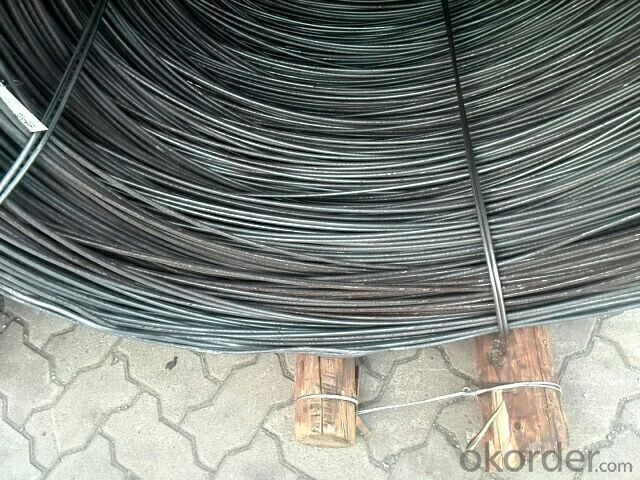
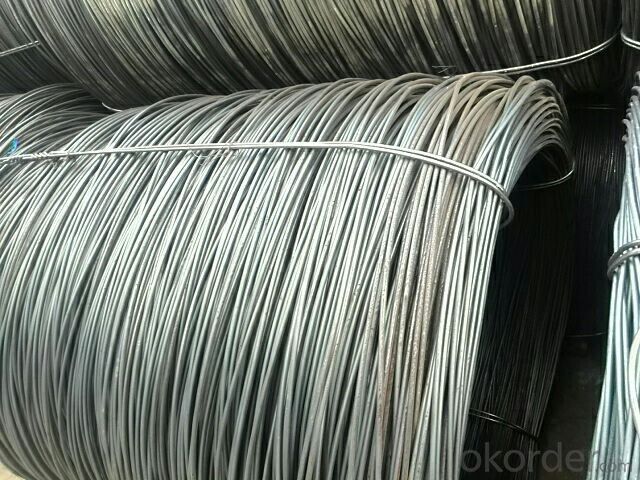
- Q: How is steel wire rod used in the manufacturing of wire for underground cable systems?
- Steel wire rod is a crucial component in the manufacturing process of wire used in underground cable systems. The steel wire rod serves as the primary raw material that is transformed into the final wire product. The production process begins with the steel wire rod being subjected to various mechanical and heat treatments to enhance its strength and durability. Once the steel wire rod has been processed, it is then drawn through a series of dies to reduce its diameter and increase its length. This drawing process helps to refine the wire's mechanical properties, such as its tensile strength and flexibility, making it suitable for underground cable applications. The drawn steel wire is then further processed to ensure it meets the specific requirements for underground cable systems. This may involve applying a protective coating, such as zinc or polymer, to enhance corrosion resistance and insulation properties. Additionally, the wire may undergo further heat treatment processes, such as annealing, to relieve internal stresses and improve its overall performance. Finally, the finished wire is wound onto spools or reels, ready to be used in the manufacturing of underground cable systems. The wire is typically combined with other components, such as insulation materials and protective layers, to form a complete cable assembly. These cables are then installed underground to facilitate the transmission of electricity, telecommunications signals, or data. Overall, steel wire rod plays a vital role in the manufacturing process of wire for underground cable systems. It provides the necessary strength, flexibility, and durability required for these cables to withstand the harsh underground environments while ensuring efficient transmission of power or information.
- Q: How is steel wire rod used in the manufacturing of wire forms for jewelry?
- Steel wire rod is an essential material used in the manufacturing of wire forms for jewelry. It is primarily utilized to create intricate and delicate wire shapes and structures that are commonly found in various types of jewelry, such as earrings, necklaces, bracelets, and rings. The steel wire rod is initially processed through a series of steps to transform it into a malleable and workable material. First, it is drawn through a die to reduce its diameter and achieve the desired thickness. This process, known as wire drawing, ensures that the steel wire rod becomes thin and pliable enough to be molded into intricate shapes. Once the wire rod has been drawn, it can be further manipulated and formed into various wire forms for jewelry. Skilled artisans use specialized tools, such as pliers, hammers, and mandrels, to bend, twist, and shape the wire into different designs. These wire forms can be as simple as loops or spirals, or they can be more complex and intricate, depending on the desired jewelry design. The steel wire rod's strength and durability make it an ideal material for creating wire forms that can withstand regular wear and tear. It provides the necessary support for gemstones, beads, and other decorative elements that may be added to the jewelry piece. Additionally, the steel wire rod's resistance to corrosion ensures that the wire forms remain intact and retain their shape over time. Furthermore, steel wire rod is often used as a base material for plating with precious metals such as gold or silver. The wire forms are coated with a thin layer of the desired metal, enhancing their aesthetic appeal and giving them a luxurious finish. This plating process adds value to the jewelry piece and makes it more visually appealing to customers. In summary, steel wire rod plays a crucial role in the manufacturing of wire forms for jewelry. Its malleability, strength, and resistance to corrosion make it an ideal material for creating intricate and durable wire shapes. Whether used as a base material or plated with precious metals, steel wire rod allows artisans to craft stunning and unique jewelry pieces that are both aesthetically pleasing and long-lasting.
- Q: What are the different methods of joining steel wire rod?
- There are several methods of joining steel wire rods, each with its own advantages and disadvantages. Some of the most common methods include welding, soldering, brazing, and mechanical joining. 1. Welding: This is the most popular method for joining steel wire rods. It involves melting the ends of the rods together using high temperatures and filling the gap with a molten filler metal. Welding provides a strong and permanent bond, but it requires skilled labor and specialized equipment. 2. Soldering: Soldering is a process that uses a lower melting point filler metal, known as solder, to join the steel wire rods. It is commonly used for smaller diameter wires and provides a relatively strong joint. However, soldered joints may not be as strong as welded joints and can be affected by high temperatures. 3. Brazing: Similar to soldering, brazing uses a filler metal with a higher melting point to join the steel wire rods. The filler metal is heated to its melting point, but below the melting point of the base metal, and then allowed to flow between the rods. Brazing offers a stronger joint than soldering and can be used for higher temperature applications. 4. Mechanical joining: This method involves mechanically connecting the steel wire rods without the use of heat or filler metals. Various mechanical joining techniques such as crimping, swaging, or using nuts and bolts can be employed. Mechanical joining is often easier and faster than other methods, but it may not provide the same level of strength or permanence. It is important to consider the specific requirements of the application, such as strength, temperature resistance, and ease of assembly, when choosing the appropriate method for joining steel wire rods. Additionally, factors such as cost, availability of equipment, and expertise required should also be taken into account.
- Q: How is steel wire rod used in the manufacturing of wire for seismic reinforcement in buildings?
- Steel wire rod is an essential component in the manufacturing of wire for seismic reinforcement in buildings. This type of wire is commonly known as seismic wire or seismic reinforcement wire. Seismic reinforcement is crucial in construction to enhance the structural integrity of buildings, especially in earthquake-prone areas. It helps to minimize the damage caused by seismic activities and ensures the safety of occupants. Steel wire rod serves as the raw material for producing seismic wire due to its desirable properties. Steel wire rod is manufactured through a process where billets, which are semi-finished steel products, are heated and then passed through a series of rollers to obtain the desired diameter. Once steel wire rod is obtained, it undergoes further processing to transform it into seismic wire. This process involves a series of steps such as drawing, annealing, and galvanizing. Drawing involves pulling the wire through a series of dies to reduce its diameter and increase its strength. Annealing is a heat treatment process that helps improve the wire's ductility and flexibility, making it more suitable for seismic reinforcement applications. Galvanizing is the process of applying a protective zinc coating to the wire to prevent corrosion. The resulting seismic wire, made from steel wire rod, is then used in various ways to reinforce buildings. It is commonly used in reinforced concrete structures, where it is embedded within the concrete to increase its tensile strength. The wire is typically formed into grids or meshes that are placed strategically within the concrete to provide additional strength and prevent cracks or failure during seismic events. Moreover, seismic wire can also be used in the form of steel ropes or cables, which are tensioned and anchored to different parts of a building. These cables help distribute the seismic forces horizontally and vertically, reducing the overall stress on the structure and improving its resistance to earthquakes. In summary, steel wire rod plays a vital role in the manufacturing of wire for seismic reinforcement in buildings. Through a series of processes, steel wire rod is transformed into seismic wire, which is used in reinforced concrete structures and as tensioned cables to enhance the structural integrity of buildings and mitigate damage caused by seismic activities.
- Q: What are the main factors affecting the fatigue resistance of steel wire rod?
- The main factors affecting the fatigue resistance of steel wire rod include the material composition, surface condition, manufacturing process, applied stress levels, and environmental conditions. Additionally, factors such as the presence of defects, notch sensitivity, and the level of pre-existing damage also influence the fatigue resistance.
- Q: How is the steel wire rod market expected to grow in the future?
- The steel wire rod market is expected to witness steady growth in the future due to several factors. Increasing infrastructure development projects and construction activities worldwide will drive the demand for steel wire rods for reinforcement purposes. Additionally, the growing automotive industry and the need for lightweight, fuel-efficient vehicles will further boost the market. Moreover, the rising demand for steel wire rods in electrical power transmission and manufacturing sectors will contribute to the market's growth. However, the market may face challenges such as fluctuating raw material prices and environmental concerns. Overall, the steel wire rod market is anticipated to expand in the coming years, supported by various end-use industries.
- Q: What are the major players in the global steel wire rod market?
- ArcelorMittal, Nippon Steel Corporation, Tata Steel Ltd., POSCO, JFE Steel Corporation, Nucor Corporation, Steel Authority of India Limited (SAIL), EVRAZ plc, Gerdau S.A., and Sohar Steel LLC are among the key players in the global steel wire rod market. These companies are renowned manufacturers and suppliers of steel wire rod, which finds extensive application in industries like construction, automotive, and manufacturing. They possess a significant market share and maintain a strong presence in vital markets worldwide. To stay competitive, these industry leaders consistently invest in research and development to develop innovative products and enhance their production processes. They also prioritize strategic alliances, acquisitions, and expansion initiatives to broaden their market reach and fortify their position in the global steel wire rod market.
- Q: What are the different ductility testing methods for steel wire rod?
- There are several ductility testing methods available for steel wire rod. These methods are used to measure the ability of the material to deform under tensile stress without breaking. Some of the common ductility testing methods for steel wire rod include the following: 1. Tensile Test: This is the most common method used to assess the ductility of steel wire rods. In this test, a specimen of the wire rod is subjected to a gradually increasing tensile force until it breaks. The elongation and reduction in area of the specimen are measured, which provide valuable information about the ductility of the material. 2. Bend Test: This test involves bending a specimen of the wire rod to a specified angle without causing any cracks or fractures. The ability of the material to withstand bending without breaking indicates its ductility. The angle of bending and any visible defects are recorded to evaluate the ductility properties. 3. Cupping Test: This test is performed to determine the deep-drawing quality of steel wire rods. A specimen is placed over a die and a punch is used to deform it into a cup shape. The ability of the material to undergo deformation without cracking or tearing indicates its ductility. 4. Charpy Impact Test: While primarily used to measure the toughness of materials, the Charpy impact test is also indicative of the ductility of steel wire rods. In this test, a notched specimen is subjected to a high-velocity impact from a swinging pendulum. The energy absorbed during fracture is measured, and if the material exhibits high energy absorption, it suggests good ductility. 5. Fatigue Test: This test is used to assess the fatigue resistance of steel wire rods, which indirectly indicates their ductility. The specimen is subjected to repeated cyclic loading, and the number of cycles required for failure is recorded. A material with high ductility is expected to have better fatigue resistance. These testing methods provide valuable information about the ductility properties of steel wire rods, helping engineers and manufacturers select the appropriate material for specific applications.
- Q: How is steel wire rod used in the manufacturing of wire netting?
- Steel wire rod is used in the manufacturing of wire netting as the primary material. It is drawn through a series of dies to reduce its diameter and increase its length, resulting in a thin and elongated wire. This wire is then woven or welded together to form the mesh structure of the wire netting. The high tensile strength and durability of steel wire rod make it an ideal choice for constructing wire netting, which is commonly used for fencing, screening, and reinforcement purposes in various industries.
- Q: What are the common applications of pre-stressed and oil tempered steel wire rod?
- Pre-stressed steel wire rod is commonly used in construction and engineering applications, such as for pre-tensioning or post-tensioning of concrete structures, bridges, and high-rise buildings. It helps to improve the load-bearing capacity, durability, and overall structural integrity of these projects. On the other hand, oil tempered steel wire rod is frequently utilized in the manufacturing of springs, suspension systems, and other high-stress applications. Its unique properties, obtained through the tempering process, provide excellent resistance to fatigue and ensure reliable performance in demanding industries such as automotive, aerospace, and machinery.
Send your message to us
Wire Rod Sae1006B and Q235 with High quality
- Loading Port:
- Tianjin
- Payment Terms:
- TT or LC
- Min Order Qty:
- 25 m.t
- Supply Capability:
- 20000 m.t/month
OKorder Service Pledge
OKorder Financial Service
Similar products
Hot products
Hot Searches
Related keywords



